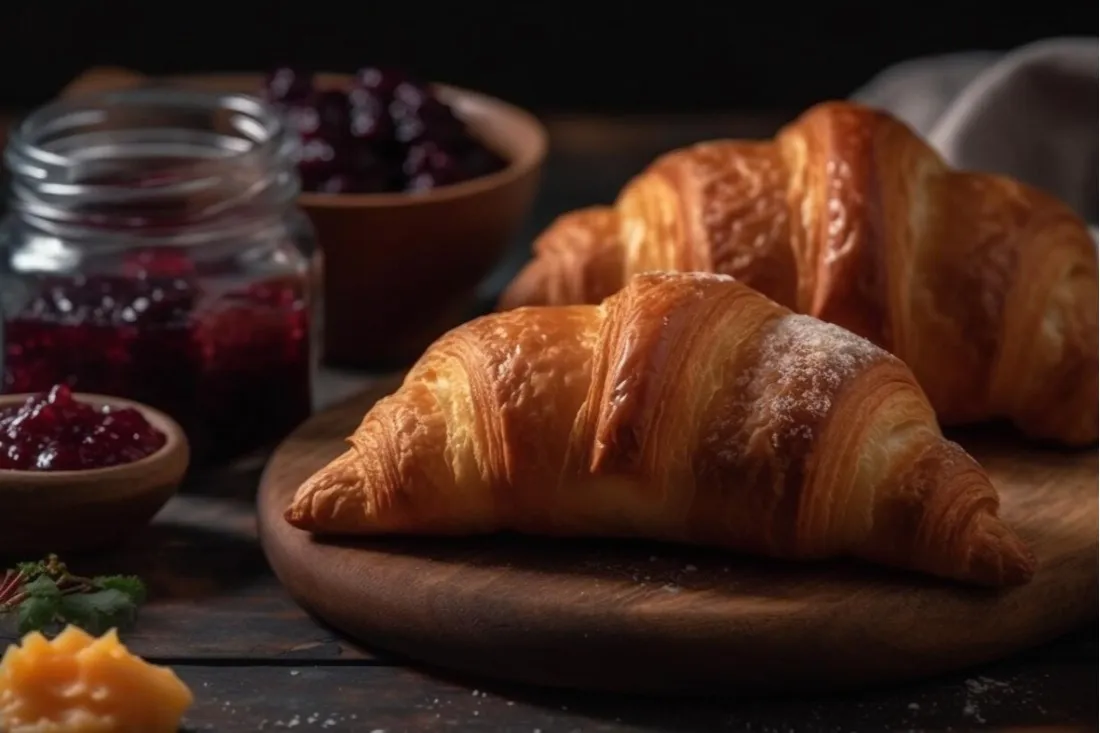In the culinary world, certain creations capture our imagination and tantalize our taste buds in ways we never thought possible. One such marvel is the croissant toast, a delightful fusion of traditional French baking and modern culinary innovation. This article delves into the world of croissant toast, exploring its origins, the intricate process of making it, its versatile culinary uses, nutritional aspects, and much more. We’ll also address some frequently asked questions, providing a comprehensive guide to this exquisite pastry. So, let’s embark on this flaky, buttery journey and discover the secrets behind the beloved croissant toast.
Introduction to Croissant Toast
The Rise of Croissant Toast
Croissant toast, a name that instantly evokes images of flaky layers and buttery goodness, is more than just a breakfast item; it’s a culinary sensation. Originating from the classic French croissant, this innovative creation has taken the world by storm. But what exactly sparked this delicious revolution?
The answer lies in the quest for convenience and versatility. Traditional croissants, with their crescent shape and delicate structure, are a staple in French cuisine. However, they posed a challenge – fitting awkwardly in toasters and often crumbling under the pressure of slicing. Enter the ingenious idea of croissant toast: a loaf-shaped croissant, pre-sliced for ease and longevity. This simple yet revolutionary concept transformed the way we enjoy this classic pastry. The traditional French croissant is a cornerstone of this pastry’s history, with a rich background worth exploring.
What Makes Croissant Toast Unique?
At its heart, croissant toast is a testament to the art of baking. It retains the essence of a traditional croissant – the flaky layers, the rich buttery taste – but introduces a new form factor that’s both practical and delightful. The uniqueness of croissant toast lies in its structure: 27 layers of dough and butter, meticulously crafted to achieve the perfect balance of crispness and tenderness.
This transformation from a traditional croissant to a loaf-shaped toast isn’t just about shape and convenience. It’s about reimagining a classic, giving it a new role in our daily lives. Croissant toast is not just for breakfast; it’s a versatile ingredient that can be the star of both sweet and savory dishes, making it a favorite among chefs and home cooks alike.
Crafting the Perfect Croissant Toast

Ingredients and Variations
The journey of making croissant toast begins with selecting premium ingredients. The foundation is high-quality flour, often sourced from renowned mills like Central Milling, known for their artisanal flours. This is combined with rich American dairy butter, creating a dough that’s both tender and flavorful. Remarkably, this culinary delight achieves its mouth-watering taste without relying on eggs, making it a unique variant in the world of pastries.
Variety is the spice of life, and croissant toast embraces this adage with open arms. From the classic butter version to more adventurous types like cinnamon, chocolate, and even vegan options, there’s a croissant toast for every palate. Each variant brings its own unique twist, catering to a range of taste preferences and dietary needs.
The Art of Baking Croissant Toast
Baking croissant toast is an art form, requiring skill, patience, and precision. The process is a dance of timing and temperature, where the dough is layered with butter and then meticulously folded to create those signature 27 layers. This technique, known as laminating, is crucial for achieving the toast’s iconic flaky texture.
The dough then undergoes a slow fermentation process, resting at low temperatures to prevent the yeast from activating too soon. This careful, prolonged fermentation is key to developing the dough’s flavor and texture, ensuring that each slice of croissant toast is a perfect blend of crispness and softness. Understanding the right baking techniques is crucial for achieving the perfect texture in croissant toast.
The 27 Layers of Flakiness
The heart of croissant toast’s allure lies in its layers. Each of the 27 layers is a testament to the baker’s craft, with the alternating sheets of dough and butter creating a labyrinth of flavor and texture. When baked, these layers puff up, turning golden and crispy on the outside while remaining soft and airy on the inside. It’s this intricate structure that sets croissant toast apart, making it a culinary masterpiece.
Culinary Delights

Sweet and Savory Pairings
Croissant toast, with its flaky texture and buttery richness, is a canvas for culinary creativity. Its versatility shines in both sweet and savory pairings. On the sweet side, imagine it slathered with rich Nutella, topped with a sprinkle of powdered sugar, or paired with fresh berries and a dollop of whipped cream. These combinations transform the humble toast into a decadent treat, perfect for a luxurious breakfast or a sumptuous dessert.
On the savory front, the toast takes on a whole new character. It can be the base for a hearty sandwich, layered with creamy avocado, smoked salmon, or even a classic egg and cheese combination. The buttery layers of the toast add a gourmet touch to these everyday favorites, elevating them from simple meals to culinary delights. Transform your croissant toast into a luxurious dessert, similar to how a bundt cake offers a unique twist on traditional cakes
Innovative Recipes with Croissant Toast
The potential of croissant toast extends beyond traditional pairings. Chefs and home cooks alike have embraced its unique texture and flavor, incorporating it into innovative recipes. Imagine a croissant toast bread pudding, where the buttery slices soak up a rich custard, baked to golden perfection. Or consider a savory twist with a croissant toast strata, layering the toast with cheese, vegetables, and eggs for a brunch-worthy dish.
These creative uses showcase the adaptability of croissant toast, making it a valuable ingredient in both classic and contemporary recipes. Its ability to blend seamlessly into various culinary contexts while still maintaining its distinct identity is what makes it a favorite in kitchens around the world. The culinary versatility of croissant toast allows it to be a star ingredient in various meal types, from breakfast to dinner.
Breakfast to Dessert: Versatility of Croissant Toast
The true beauty of croissant toast lies in its versatility. From a quick, comforting breakfast to an elegant dessert, it fits effortlessly into any meal of the day. Its ability to pair with a wide range of ingredients – from the simplest jams to the most elaborate toppings – makes it a staple for both quick meals and elaborate feasts.
Health and Nutrition
Nutritional Profile of Croissant Toast
When indulging in the buttery layers of croissant toast, it’s natural to ponder its nutritional aspects. While croissant toast is a treat, understanding its nutritional profile can help in making informed dietary choices. Typically, the toast is rich in carbohydrates, primarily from the high-quality flour used in its preparation. It also contains a significant amount of fats, owing to the butter layers that give it its distinctive flakiness and taste.
However, it’s worth noting that many bakeries, including those that supply to Whole Foods Market, are now offering healthier variants. These may include options made with whole grain flour, reduced butter content, or even incorporating plant-based fats for a vegan-friendly version. Such alternatives provide a way to enjoy the toast while aligning with various dietary preferences and health considerations.
Balancing Taste and Health
Enjoying croissant toast as part of a balanced diet is all about moderation and understanding. Pairing a slice of croissant toast with nutrient-rich toppings like fresh fruits, nuts, or a side of yogurt can enhance its nutritional value. For those concerned about calorie intake, opting for a smaller portion or a lighter version of the toast can be a wise choice.
It’s also important to consider the overall dietary pattern. Enjoying croissant toast as an occasional treat, rather than a daily staple, can be a part of a healthy, balanced diet. This approach allows for the enjoyment of its rich, buttery goodness without overindulgence.
Consumer Insights

Testimonials and Reviews
The allure of croissant toast isn’t just in its taste and versatility; it’s also reflected in the glowing testimonials and reviews from consumers. People are not just eating it; they’re raving about it. From social media posts celebrating its flaky layers to online reviews praising its perfect balance of crispness and softness, croissant toast has garnered a loyal following.
Customers often highlight the unique experience of enjoying a traditional croissant in a more convenient and versatile loaf form. They share stories of delightful breakfasts, innovative recipes, and the joy of introducing this culinary gem to family and friends. These personal anecdotes and endorsements underscore the product’s success and its resonance with a diverse audience.
Market Trends and Popularity
The popularity of croissant toast is more than a fleeting trend; it’s a reflection of broader market shifts. There’s a growing demand for gourmet, artisanal bread products that offer both quality and convenience. the toast fits perfectly into this niche, appealing to both the epicurean seeking a luxurious treat and the busy individual looking for a quick yet satisfying meal.
This trend is also evident in the expanding availability of croissant toast in mainstream markets. Once a specialty item found only in artisan bakeries or upscale grocery stores, it’s now increasingly common in local supermarkets and even online stores. This wider availability is a testament to its growing popularity and the public’s appetite for innovative, high-quality baked goods.
Frequently Asked Questions
Common Queries About Croissant Toast
Croissant toast, with its unique blend of tradition and innovation, naturally sparks curiosity. Here, we address some of the most common questions to enhance your understanding and enjoyment of this delightful pastry.
Q: How is croissant toast different from regular toast or a traditional croissant?
A: Croissant toast combines the best of both worlds. Unlike regular toast, it boasts a rich, buttery flavor and flaky texture, akin to a traditional croissant. However, its loaf form and pre-sliced nature make it more convenient and versatile than a classic croissant, fitting easily into a toaster and offering more uniform slices.
Q: Can croissant toast be frozen for later use?
A: Absolutely! Freezing croissant toast is a great way to extend its shelf life. Wrap it tightly to prevent freezer burn and thaw it at room temperature when you’re ready to enjoy. Toasting it after thawing revives its crispness and flavor, making it just as delightful as when it’s fresh.
Q: Are there any healthier versions of croissant toast available?
A: Yes, many bakeries now offer healthier variants of the toast. These may include options made with whole grain flour, reduced butter content, or plant-based fats. Such versions cater to health-conscious consumers and those with specific dietary preferences.
Expert Answers to Popular Questions
Q: What are some creative ways to enjoy croissant toast?
A: The possibilities are endless! Apart from the classic breakfast toast, you can use croissant toast in sweet dishes like bread pudding or French toast. For savory options, consider using it as the base for a luxurious sandwich or a rich, cheesy strata. Its versatility makes it perfect for experimentation.
Q: How long does croissant toast stay fresh?
A: When stored properly in a cool, dry place, croissant toast can stay fresh for several days. Keeping it in an airtight container helps maintain its texture and flavor. If you plan to keep it longer, freezing is the best option.
Wrapping Up the Croissant Toast Journey
Final Thoughts
Our journey through the world of croissant toast reveals its unique place in the culinary landscape. It’s a delightful fusion of tradition and innovation. This pastry has evolved from a classic French delicacy to a modern kitchen favorite, reflecting our love for quality and versatility in food.
Future of Croissant Toast
Looking forward, the prospects for croissant toast are as exciting as its taste. Its popularity is soaring, and its variations are expanding. This positions it perfectly in the evolving world of artisanal baking and gourmet cuisine. As we increasingly favor quality, versatility, and convenience in our food, croissant toast stands ready to satisfy these needs.
The story of the toast is about more than just taste. It’s about the ongoing evolution of our culinary preferences. This pastry is not just a treat; it’s a symbol of how we can reinvent traditions to suit our modern tastes and lifestyles.
So, as we enjoy our the toast, let’s appreciate the craftsmanship and innovation behind it. Here’s to the joy and culinary creativity it brings into our lives. Cheers to many more delightful moments with croissant toast!

